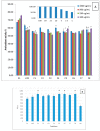Production of Bioactive Compounds from the Sulfated Polysaccharides Extracts of Ulva lactuca: Post-Extraction Enzymatic Hydrolysis Followed by Ion-Exchange Chromatographic Fractionation
- PMID: 31195764
- PMCID: PMC6600532
- DOI: 10.3390/molecules24112132
Production of Bioactive Compounds from the Sulfated Polysaccharides Extracts of Ulva lactuca: Post-Extraction Enzymatic Hydrolysis Followed by Ion-Exchange Chromatographic Fractionation
Abstract
This paper describes a novel combined post-extraction process for obtaining bioactive compounds from the aqueous high molecular weight sulfated polysaccharides (SPs) extracts of the green algae, Ulva lactuca. After extracting the SPs, they were enzymatically hydrolyzed then the hydrolysate (V45) was fractionated into eight different molecular weight fractions (F1-F8) using ion exchange chromatography. Crude SPs together with V45 and (F1-F8) were examined for their carbohydrate, protein, and sulfate contents. In addition, their degree of polymerization (DP) was estimated and they were characterized by Fourier Transform Infrared Spectroscopy (FTIR). Fractions S1, F4, F5, and F8 showed promising antioxidant and antitumor activities in vitro. In particular, the remarkable antitumor activity of F5 on three types of cancer cell lines could be attributed to its comparable contents of protein, carbohydrate, and sulfate, in addition to its comparable contents of rhamnose and glucuronic acid, and the same for glucose and arabinose. F5 also possessed the highest Hill coefficient among the four promising fractions indicating a higher degree of cooperativity in ligand binding. Other influencing factors including DP, composition, and type of characteristic functional groups were also discussed. The implications of this work could potentially benefit the industries of food supplements and pharmaceuticals.
Keywords: algae; antioxidant; antitumor activity; enzymatic hydrolysis; ion exchange chromatography; polysaccharides.
Conflict of interest statement
The authors declare no conflict of interest. The funders had no role in the design of the study; in the collection, analyses, or interpretation of data; in the writing of the manuscript, or in the decision to publish the results.
Figures





References
-
- Qi H., Zhao T., Zhang Q., Li Z., Zhao Z., Xing R. Antioxidant activity of different molecular weight sulfated polyssacharides from Ulva pertusa Kjellum (Chlorophyta) J. Appl. Phycol. 2005;17:527–534. doi: 10.1007/s10811-005-9003-9. - DOI
-
- Abd El-Baky H.H., El Baz F.K., El-Baroty G.S. Evaluation of marine alga Ulva lactuca L. as a source of natural preservative ingredient. Electron. J. Environ. Agric. Food Chem. 2008;7:3353–3367.
-
- Meenakshi S., Manicka D.G., Tamil S., Arumugam M., Balasubramanian T. Total flavanoid and in vitro antioxidant activity of two seaweeds of Rameshwaram Coast. Glob. J. Pharmacol. 2009;3:59–62.
MeSH terms
Substances
Grants and funding
LinkOut - more resources
Full Text Sources
Miscellaneous

